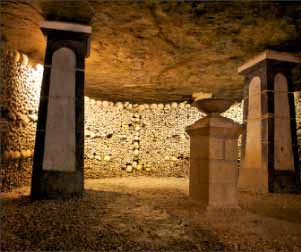For millennia, man has excavated into the earth. A type of excavation, quarrying, dates to prehistoric times and is typically performed to extract rock or minerals. A famous prehistoric example of quarried rock is Stonehenge in England, which dates to Neolithic times. In ancient Egypt, the need for building materials for pyramids and temples led to the quarrying of basalt and other rock near the cliffs of the Nile River.
Paris Collapse
The Roman Empire expanded tremendously during the 1st century BCE. Thus, an enormous demand for stone evolved to build palaces, coliseums, military fortifications, and roads. That led to quarrying throughout modern-day Europe. Massive deposits of limestone and gypsum underlying Paris, France, gave rise to some of the world’s most notable underground quarry tunnels. The Romans began quarrying limestone south of what is currently the city of Paris around 60 BCE. As surface stone deposits became scarce and open-pit quarrying became more difficult, miners began to dig vertically. Then, they excavated horizontally to extract stone deposits.

The catacombs of Paris house the remains of Parisians transferred to abandoned underground quarries from cemeteries over 200 years ago.
Architects sought limestone as a prized building material for such structures as Notre Dame and the Louvre. Much of Paris’ plaster comes from mined gypsum. Continued excavation through the 18th century led to a network that eventually comprised over 180 miles of intricately connected tunnels, passages, and caverns beneath the city.
However, experts soon discovered a problem. The extent of the underground labyrinth beneath Paris and the geotechnical risk from structures above caused some abandoned quarries’ ceilings to crack and erode. They formed “bell holes” that extended upward toward the ground surface. In 1774, a massive cave-in destroyed over 100 feet of overlying roadway, swallowing several buildings, and causing numerous deaths. In recognition of the underground tunnels’ hazard, Louis XVI appointed a special division of architects and inspectors to map them. They developed a system to shore up the cavities. The Inspection General des Carrieres still inspects the tunnels today and monitors buildings and roadways for the settlement signs.
In the early 1900s, the construction of the Paris Metro added another 132 miles of tunnels beneath the Paris metropolitan area. The massive underground network of Metro lines, sewers, and quarry tunnels caused some to label the ground under Paris as “the Gruyere Parisian” as it is full of holes like Swiss cheese.
Cholera Quarries
Toward the end of the 18th century, Paris was in the midst of an epidemic of cholera. Experts determined the epidemic was due in part to contamination related to improper burials and mass graves. In 1786, it was decided to condemn several overflowing cemeteries and discreetly remove the bones to the underground quarries. Thus, abandoned quarries underlying the city became the famed catacombs of Paris, stacked floor to ceiling with human remains. These catacombs contain over six million Parisians’ bones, nearly three times the city’s current population.
Following more cholera outbreaks, engineers revamped the underground sewer and water systems beneath Paris. That led to the construction of an additional 373 miles of underground tunnels. Unlike the smaller diameter sewers constructed in the USA, Parisian sewers are almost as large as subway tunnels. In fact, the sewer tunnels were a tourist attraction in the early 20th century. Visitors toured them via a locomotive-drawn wagon. Today, a museum celebrating the history of the sewer system still exists.
On-Going Concerns
Despite ongoing monitoring, street collapses related to underground quarries or other tunnels in Paris average 10 per year. Some examples include:
- In 1961, the ground above a disused chalk quarry gave way to a Paris suburb, destroying a soccer stadium, several city streets, and numerous buildings. In all, it wrecked a total of 23 buildings and killing 21 people.
- A massive sinkhole developed above an old gypsum quarry in the Montmarte District, threatening adjacent residential buildings and closing streets to traffic in 2001.
- In 2003, a school building collapsed while performing work on an extension of a Paris Metro line.
London Issues
Paris has not been the only major city affected by geotechnical issues associated with underground excavations. In London, the famed British landmark known as Big Ben is sinking. The 314-foot tower, located on the Thames River banks at the Palace of Westminster in Central London, tilts approximately 1.5 feet from vertical. While the tilting has been observed and monitored for many years, it is discernible to the naked eye.
The tilting rate has accelerated since 2003, increasing to 0.9 mm a year compared to the previous average of 0.65 mm a year. While experts disagree on the acceleration causes, a report commissioned by the London Underground and Parliamentary Estates Department attributes it to years of underground developments affecting the ground conditions. Among these is an underground parking structure and the extension of the London Underground Jubilee Line.
The tilting effects are visible in recently developed cracks in the walls and ceilings of some rooms within the House of Commons. The tilt is less than one-tenth of the other famous European landmark, the Leaning Tower of Pisa. Civil engineers calculate that it would take approximately 4,000 years for Big Ben to reach the angle of Pisa at the current rate of movement.
Note: Earth Systems originally published this article, Building on the Past, in a newsletter in 2012 and re-edited it here for the web.
Credits: catacombs-© iStockphoto.com/anniegreenwood; Big Ben-© Can Stock Photo Inc./Elenathewise








